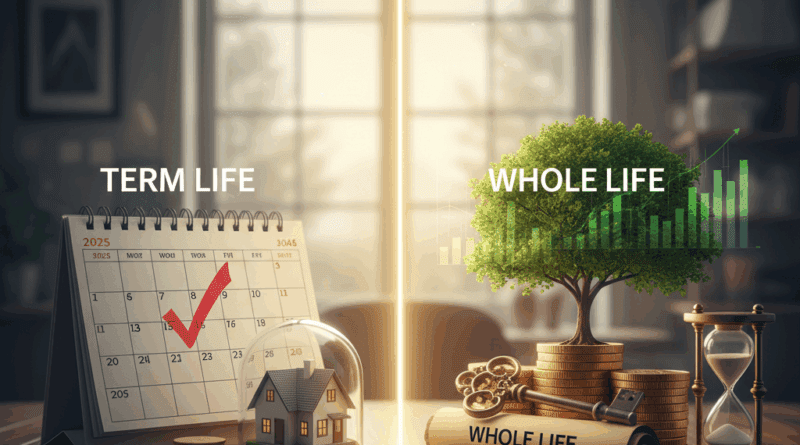Term Life vs. Whole Life Insurance: Which Policy is Right for You?
Choosing between term life insurance and whole life insurance is one of the most fundamental decisions in financial planning. Both offer crucial financial protection for your loved ones, but they serve very different purposes, come with distinct cost structures, and provide varying benefits.
This comprehensive guide will break down the core differences, advantages, and disadvantages of each policy type. Our goal is to help you understand which life insurance policy aligns best with your financial goals, family needs, and budget in 2025.
Understanding the Core Difference: Temporary vs. Permanent
The primary distinction between term and whole life insurance lies in their duration and structure:
- Term Life Insurance: This policy provides coverage for a specific period (a “term”), typically 10, 20, or 30 years. It’s often compared to renting a home – you pay for protection for a set time, and if you outlive the term, the coverage ends unless renewed.
- Whole Life Insurance: This is a type of permanent life insurance that provides coverage for your entire life (as long as premiums are paid). It’s more like owning a home – it builds cash value over time, which can be accessed later.
Knowing this core difference is crucial for navigating the details of each option.
Term Life Insurance: Pure Protection, Lower Cost
Term life insurance is often recommended for young families or individuals seeking maximum coverage at the lowest possible cost.
How it Works:
You choose a term length (e.g., 20 years) and a death benefit (e.g., $500,000). You pay fixed premiums for that term. If you pass away within the term, your beneficiaries receive the death benefit. If you outlive the term, the policy simply expires, or you may have the option to renew at a significantly higher premium.
Pros:
- Affordability: Significantly cheaper than whole life insurance, especially when young and healthy.
- Simplicity: Straightforward, easy to understand, and fulfills a clear need for temporary coverage.
- Maximized Coverage: Allows you to afford a higher death benefit when family needs are greatest (e.g., paying off a mortgage, funding children’s education).
Cons:
- Temporary Coverage: Eventually expires, potentially leaving you without coverage in old age or requiring expensive renewal.
- No Cash Value: Does not build any savings or investment component.
Who is it Best For?
- Young families with children and a mortgage.
- Individuals on a tight budget who need substantial coverage.
- People with specific, temporary financial obligations (e.g., student loans, business loans).
Whole Life Insurance: Permanent Coverage, Cash Value Growth
Whole life insurance offers lifelong protection and a unique savings component, making it a more complex and typically more expensive option.
How it Works:
You pay fixed premiums for life. A portion of each premium goes towards the death benefit, and another portion contributes to the policy’s cash value. This cash value grows on a tax-deferred basis and can be:
- Borrowed against: Like a loan from the insurer (which reduces the death benefit if not repaid).
- Withdrawn: Reducing the death benefit.
- Used to pay premiums: Allowing the policy to become “paid up.”
Pros:
- Permanent Coverage: Guarantees a death benefit for your entire life, as long as premiums are paid.
- Cash Value Accumulation: Provides a guaranteed rate of return on the savings component, offering a living benefit.
- Tax Advantages: Cash value growth is tax-deferred, and policy loans are generally tax-free.
Cons:
- Higher Cost: Significantly more expensive than term life insurance for the same death benefit.
- Lower Returns: The cash value growth typically lags behind market-based investments (e.g., stocks, ETFs).
- Complexity: Can be confusing to understand, with various riders and options.
Who is it Best For?
- High-net-worth individuals seeking estate planning tools.
- Those who want guaranteed lifetime coverage regardless of age or health.
- Individuals who struggle with saving and value a forced savings mechanism.
